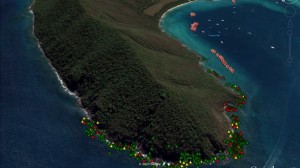Every three years, about 100 Tabor students in small groups travel down to the island of St. John throughout the winter to document the endangered Elkhorn Coral in the bays of the island. The Caribbean Studies Program, directed by Dr. John Crosby, was successfully completed at the start of this month after hundreds of coral were recorded and examined by each of the six cruises.
There has been an 85% decline in the population of Elkhorn Coral in the Caribbean in the last 25 years due to storm damage and disease. This past winter, Tabor students inspected and recorded the health of the coral to further hypothesize the causes and effects of this declination in population. They specifically focused on water circulation patterns and how this may trap polluted water in the bays and contaminate the coral. Tabor’s Caribbean Studies Program collaborates with the U.S. Geological Survey, the Virgin Islands National Park Service, and the U.S. Department of the Interior in order to further the effort to protect and save the Elkhorn.
Emily Chandler taught the preparation course for students involved in the program and was the on-board director for three of the cruises. Chandler finds that, “what makes the Caribbean Studies Program unique is it gives Tabor students the opportunity to conduct real scientific research and generate results that can have an immediate impact. For example, research from the 2005 program provided the NPS with the data necessary to put Elkhorn Coral on the protected species list. ” With much success this past winter, more progress in the fight to save the Elkhorn is sure to be made.
While students spend the start of their trip practicing their snorkeling skills and learning about the history and culture of the Virgin Islands in the warm Caribbean sun, the end of each trip was spent solely doing hour-long research dives four or five times a day. Although students took a semester-long course to learn about the coral and research technique, the state of the coral was still shocking.
“It wasn’t until I saw the coral reefs that I realized just how threatened the coral is,” said Olivia Palombo, a junior who participated in the program.
The students worked in groups of three to examine the coral. One dove to look at the coral’s diseases, another then recorded the findings on a PDA, while the third took photographs of the specific coral. This gave all of the students a very unique experience in doing actual fieldwork.
However, the students did more than just study the coral reefs. Each group used fluorescein dye to monitor the currents in the bays and used a PDA to track the patterns of their movement. Students also ran snap tests to examine the water chemistry and these showed that there were low concentration levels of nitrate, phosphate, dissolved oxygen, dissolved carbon dioxide, iron, and copper.
The students were onboard SSV Tabor Boy, Tabor Academy’s schooner, with the crew during their time in the Caribbean. The schooner is a major part of Tabor Academy and the experience of students. Students sail Tabor Boy as an after-school activity in the fall and spring, and it is the site of weeklong summer orientation programs. Tabor Boy has had a big year, as 2014 marks the 100th birthday of the vessel.
Tabor Boy is now returning home and is stopping for celebrations along the way with receptions along the east coast. Tabor is very fortunate to have this schooner to enhance the experience that students have at this “school by the sea” and to continue the successful Caribbean Studies Program.
By Julia O’Rourke
